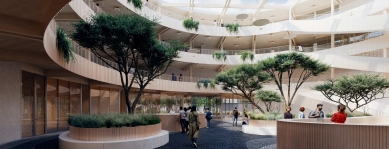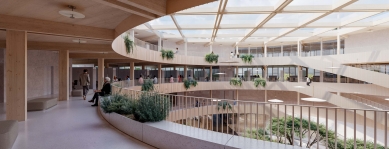
<html>Dům městských služeb v Ostravě - vítězný projekt</html> <html>House of City Services in Ostrava - winning project</html>
Source
Zuzana Kotyzová, MAPPA Ostrava
Zuzana Kotyzová, MAPPA Ostrava
Publisher
Tisková zpráva
05.08.2025 18:15
Tisková zpráva
05.08.2025 18:15
Czech Republic
Ostrava
építész stúdió kft.
The winning proposal from the Hungarian studio Építész Stúdió impressed the jury of the architectural competition for the City Services Building with its thoughtful layout, sensitive integration into the environment of Černá louka, and emphasis on sustainability. The new building aims to provide facilities for departments handling citizens' and driver's licenses or passports, as well as several city organizations. It also includes exhibition space for the Ostrava Puppet Theatre, services, and shops on the ground floor.
The design offers a sustainable timber structure that utilizes passive ventilation, features a green roof enhanced with photovoltaics, and incorporates a system for using rainwater for irrigation. The circular floor plan of the building naturally fits into the diverse urban fabric of Černá louka, where historical buildings meet more modern exhibition pavilions. The arrangement of its interior spaces creates a pleasant and clear environment for visitors and office staff. A distinctive element of the design is the flexible layout of the office spaces, allowing easy adjustment of room sizes according to the current needs of departments overseeing transportation and internal affairs. The through atrium is to be complemented with greenery, naturally linking the building with the surrounding park. Two underground levels of the building will be reserved for parking; however, good accessibility will also be ensured by public transport, as a public transport stop is planned nearby.
“The competition confirmed the high level of the participating teams and the relevance of the topic of centralizing urban services. We consider the winning proposal to be a valuable output that provides important professional reflection and inspiration for the further development of Černá louka and the city as a whole,” stated Deputy Mayor Lucie Baránková Vilamová.
The jury selected the winner from seven anonymously assessed proposals that advanced to the second round of the architectural competition from a total of twenty-one participants. “The compact circular shape of the building provides a clear urban response to the fragmented surroundings of the object and creates a strong yet inviting urban element. We appreciate the coherent internal layout, a public-friendly environment, an open ground floor, and the emphasis on sustainability and operational efficiency. The proposal presents a functional public building that also has the potential to become another iconic structure of the city,” said the jury chairman, architect Ivo Koukol.
The jury consisted of independent experts and representatives of the city of Ostrava. It included architects Ivo Koukol, Rudolf Grimm, Petr Hrůša, architects Yvette Vašourková, Viktorie Součková, Milena Vitoulová, and engineer Jan Růžička. The dependent part of the jury was represented by Deputy Mayor Lucie Baránková Vilamová, Deputy Břetislav Riger, Secretary of the City of Ostrava Břetislav Gibas, Councilor of MOb Moravská Ostrava and Přívoz Zuzana Ožanová, Head of Urban Planning Department Cyril Vltavský, and Director of MAPPA Ondřej Vysloužil. The proposals were evaluated in terms of architectural quality, operational economy, economic conformity of the building, flexible use, and sustainability. The jury also assessed the degree of fulfillment of the assignment and the incorporation of remarks from the first round of the competition.
The winning author team from Építész Stúdió comprises architects Gergely Kenéz, Csenge Király, and Luca Mudry in collaboration with landscape architects Júlia Bobríková and Barbora Kubická. The second place was awarded to the proposal from the studio Kuba & Pilař architects, and the third place went to the Brno studio Peer collective.
The city will announce further steps related to the new facilities for the departments of the municipality currently located in rented and operationally inadequate spaces in the coming weeks. The public will then be able to view all competition proposals at an autumn exhibition at the city studio MAPPA, which organized the competition in collaboration with the city.
The design offers a sustainable timber structure that utilizes passive ventilation, features a green roof enhanced with photovoltaics, and incorporates a system for using rainwater for irrigation. The circular floor plan of the building naturally fits into the diverse urban fabric of Černá louka, where historical buildings meet more modern exhibition pavilions. The arrangement of its interior spaces creates a pleasant and clear environment for visitors and office staff. A distinctive element of the design is the flexible layout of the office spaces, allowing easy adjustment of room sizes according to the current needs of departments overseeing transportation and internal affairs. The through atrium is to be complemented with greenery, naturally linking the building with the surrounding park. Two underground levels of the building will be reserved for parking; however, good accessibility will also be ensured by public transport, as a public transport stop is planned nearby.
“The competition confirmed the high level of the participating teams and the relevance of the topic of centralizing urban services. We consider the winning proposal to be a valuable output that provides important professional reflection and inspiration for the further development of Černá louka and the city as a whole,” stated Deputy Mayor Lucie Baránková Vilamová.
The jury selected the winner from seven anonymously assessed proposals that advanced to the second round of the architectural competition from a total of twenty-one participants. “The compact circular shape of the building provides a clear urban response to the fragmented surroundings of the object and creates a strong yet inviting urban element. We appreciate the coherent internal layout, a public-friendly environment, an open ground floor, and the emphasis on sustainability and operational efficiency. The proposal presents a functional public building that also has the potential to become another iconic structure of the city,” said the jury chairman, architect Ivo Koukol.
The jury consisted of independent experts and representatives of the city of Ostrava. It included architects Ivo Koukol, Rudolf Grimm, Petr Hrůša, architects Yvette Vašourková, Viktorie Součková, Milena Vitoulová, and engineer Jan Růžička. The dependent part of the jury was represented by Deputy Mayor Lucie Baránková Vilamová, Deputy Břetislav Riger, Secretary of the City of Ostrava Břetislav Gibas, Councilor of MOb Moravská Ostrava and Přívoz Zuzana Ožanová, Head of Urban Planning Department Cyril Vltavský, and Director of MAPPA Ondřej Vysloužil. The proposals were evaluated in terms of architectural quality, operational economy, economic conformity of the building, flexible use, and sustainability. The jury also assessed the degree of fulfillment of the assignment and the incorporation of remarks from the first round of the competition.
The winning author team from Építész Stúdió comprises architects Gergely Kenéz, Csenge Király, and Luca Mudry in collaboration with landscape architects Júlia Bobríková and Barbora Kubická. The second place was awarded to the proposal from the studio Kuba & Pilař architects, and the third place went to the Brno studio Peer collective.
The city will announce further steps related to the new facilities for the departments of the municipality currently located in rented and operationally inadequate spaces in the coming weeks. The public will then be able to view all competition proposals at an autumn exhibition at the city studio MAPPA, which organized the competition in collaboration with the city.
The English translation is powered by AI tool. Switch to Czech to view the original text source.




0 comments
add comment










